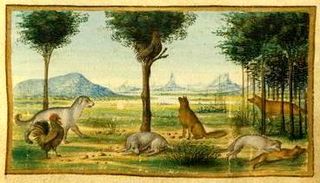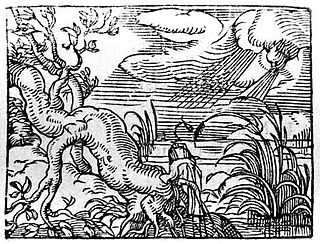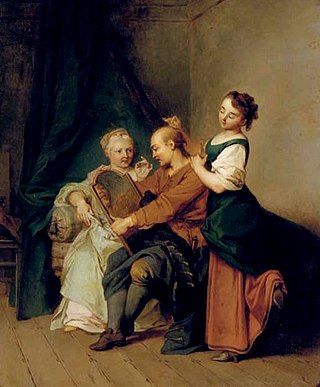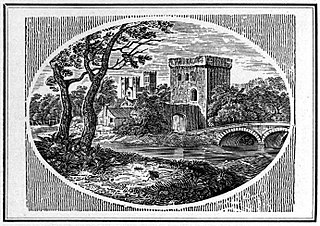
Aesop's Fables, or the Aesopica, is a collection of fables credited to Aesop, a slave and storyteller who lived in ancient Greece between 620 and 564 BCE. Of diverse origins, the stories associated with his name have descended to modern times through a number of sources and continue to be reinterpreted in different verbal registers and in popular as well as artistic media.

The Frog and the Ox appears among Aesop's Fables and is numbered 376 in the Perry Index. The story concerns a frog that tries to inflate itself to the size of an ox, but bursts in the attempt. It has usually been applied to socio-economic relations.

The Ant and the Grasshopper, alternatively titled The Grasshopper and the Ant, is one of Aesop's Fables, numbered 373 in the Perry Index. The fable describes how a hungry grasshopper begs for food from an ant when winter comes and is refused. The situation sums up moral lessons about the virtues of hard work and planning for the future.
The lion's share is an idiomatic expression which now refers to the major share of something. The phrase derives from the plot of a number of fables ascribed to Aesop and is used here as their generic title. There are two main types of story, which exist in several different versions. Other fables exist in the East that feature division of prey in such a way that the divider gains the greater part - or even the whole. In English the phrase used in the sense of nearly all only appeared at the end of the 18th century; the French equivalent, le partage du lion, is recorded from the start of that century, following La Fontaine's version of the fable.

The Farmer and the Stork is one of Aesop's Fables which appears in Greek in the collections of both Babrius and Aphthonius and has differed little in the telling over the centuries. The story relates how a farmer plants traps in his field to catch the cranes and geese that are stealing the seeds he has sown. When he checks the traps, he finds among the other birds a stork, who pleads to be spared because it is harmless and has taken no part in the theft. The farmer replies that since it has been caught in the company of thieves, it must suffer the same fate. The moral of the story, which is announced beforehand in the oldest texts, is that associating with bad companions will lead to bad consequences.

Belling the Cat is a fable also known under the titles The Bell and the Cat and The Mice in Council. In the story, a group of mice agree to attach a bell to a cat's neck to warn of its approach in the future, but they fail to find a volunteer to perform the job. The term has become an idiom describing a group agreeing to perform an impossibly difficult task.

The Fox and the Crow is one of Aesop's Fables, numbered 124 in the Perry Index. There are early Latin and Greek versions and the fable may even have been portrayed on an ancient Greek vase. The story is used as a warning against listening to flattery.

The Tortoise and the Birds is a fable of probable folk origin, early versions of which are found in both India and Greece. There are also African variants. The moral lessons to be learned from these differ and depend on the context in which they are told.

Aesop was a Greek fabulist and storyteller credited with a number of fables now collectively known as Aesop's Fables. Although his existence remains unclear and no writings by him survive, numerous tales credited to him were gathered across the centuries and in many languages in a storytelling tradition that continues to this day. Many of the tales associated with him are characterized by anthropomorphic animal characters.

The Wolf and the Crane is a fable attributed to Aesop that has several eastern analogues. Similar stories have a lion instead of a wolf, and a stork, heron or partridge takes the place of the crane.
The Ass in the Lion's Skin is one of Aesop's Fables, of which there are two distinct versions. There are also several Eastern variants, and the story's interpretation varies accordingly.

The Wolf and the Lamb is a well-known fable of Aesop and is numbered 155 in the Perry Index. There are several variant stories of tyrannical injustice in which a victim is falsely accused and killed despite a reasonable defence.

The Fox and the Stork, also known as The Fox and the Crane, is one of Aesop's fables and is first recorded in the collection of Phaedrus. It is numbered 426 in the Perry Index.

The Cock, the Dog and the Fox is one of Aesop's Fables and appears as number 252 in the Perry Index. Although it has similarities with other fables where a predator flatters a bird, such as The Fox and the Crow and Chanticleer and the Fox, in this one the cock is the victor rather than victim. There are also Eastern variants of this story.

The Oak and the Reed is one of Aesop's Fables and is numbered 70 in the Perry Index. It appears in many versions: in some it is with many reeds that the oak converses and in a late rewritten version it disputes with a willow.
The young man and the swallow is one of Aesop's Fables and is numbered 169 in the Perry Index. It is associated with the ancient proverb 'One swallow doesn't make a summer'.

The Man with Two Mistresses is one of Aesop's Fables that deals directly with human foibles. It is numbered 31 in the Perry Index.

Hercules and the Wagoner or Hercules and the Carter is a fable credited to Aesop. It is associated with the proverb "God helps those who help themselves", variations on which are found in other ancient Greek authors.
There are no less than six fables concerning an impertinent insect, which is taken in general to refer to the kind of interfering person who makes himself out falsely to share in the enterprise of others or to be of greater importance than he is in reality. Some of these stories are included among Aesop's Fables, while others are of later origin, and from them have been derived idioms in several languages.

The Fly and the Ant is one of Aesop’s Fables that appears in the form of a debate between the two insects. It is numbered 521 in the Perry Index.


















